What is Pemphigus? A Personal Perspective
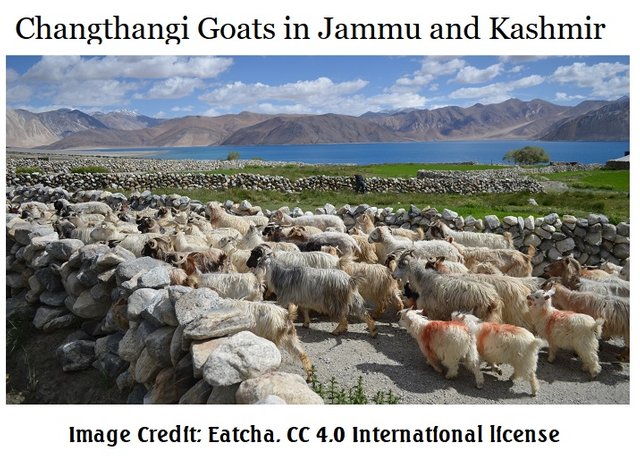
About twenty years ago I showed my doctor a spot behind my left ear. The doctor referred me to a dermatologist who performed a biopsy. The report came back: pemphigus vulgaris. I looked that up on the Internet and refused to accept the idea, so I went to a research hospital. Second biopsy: pemphigus vulgaris.
A powerful topical steroid erased the spot quickly and it never came back. As you read this blog you will see that my fortune was good in the extreme. Pemphigus can run a cruel course, and it can take a life. Many, many people who receive the same pathology report I did, do not share my good fortune.
Here's some of what I learned about pemphigus in the ensuing years. The information might be useful someday, for you, your family or your pet. Pemphigus affects animals, too.

Certain dog breeds are more susceptible to pemphigus than others. These breeds include Akita, Chow Chow, and Cocker Spaniels.
What is It?
According to Merk Manual:
"Pemphigus vulgaris is an uncommon, potentially fatal, autoimmune
disorder characterized by intraepidermal blisters and extensive erosions
on apparently healthy skin and mucous membranes". 1
Translated into ordinary language: pemphigus is very rare, and it can be fatal. Blisters form within the cells of the upper layer of skin. With a particular type of pemphigus, pemphigus vulgaris, blisters also form in the mucous membranes.
Pemphigus is categorized as an orphan disease by the U.S. Food and Drug Administration. The occurrence of pemphigus varies by region across the globe, and also by ethnicity. It ranges between 0.7 and 5 people, per million. Populations with a Mediterranean or Ashkenazi Jewish background are at higher risk. The incidence in these populations may be as high as 6-32 cases per million. A particular subset of pemphigus (endemic pemphigus) occurs with greater frequency in the Brazilian rainforest and in Colombia.
There are photos available on the Internet, of people afflicted with pemphigus. I'd feel I was violating those people if I used such distressing, personal photos. However I did find an illustration that is less intrusive and yet reflects how extensively pemphigus can affect the skin. This picture shows a patient (in 1896) with pemphigus foliaceus, PF, a less fatal type of the disease than pemphigus vulgaris, PV.
The severe condition of this patient is one that was suffered by most before the introduction of modern treatments.
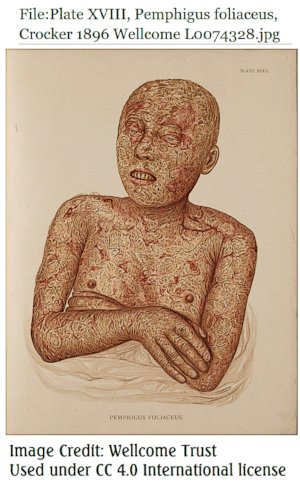
Types of Pemphigus
As I poured through the literature, the words pemphigus and pemphigoid appeared in different contexts. A variety of blistering diseases can be characterized by the words pemphigus or pemphigoid. I found some categorical clarity in a 2016 article, Mechanisms of Disease: Pemphigus and Bullous Pemphigoid, published in the Annual Review of Pathology. The authors separate the histological character (tissue analysis, available from a biopsy) of the disease from its clinical manifestations (what does it look like, what are the symptoms).
According to this article (and also according to the International Pemphigus and Pemphigoid Foundation), histologically there are two types: pemphigus vulgaris--PV-- and pemphigus foliaceus--PF . In tissue samples of both types there will be evidence of autoantibodies.. It is the type of autoantibody and its specific target tissue that become diagnostic in pemphigus. A pathologist assesses this in a biopsy.
In pemphigus, autoantibodies target a specific substance found in the epidermis: desmoglein. With the destruction of desmoglein, essential cells, called keratinocytes, cannot hold together. Blisters form in those areas of failure and the skin essentially falls apart.
Keratinocytes
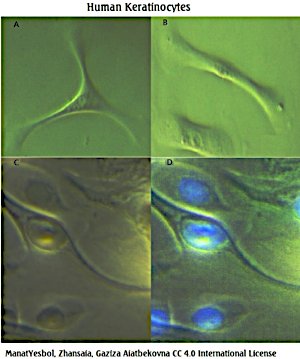
Keratinocytes make up about 95% of the epidermis. Without treatment, a pemphigus patient may actually lose most of the epidermis. This would lead to fluid loss, widespread infection, and likely sepsis. Most patients would die in about two years.
There are different types of desmoglein. A diagnosis of PV or PF is based on which kind of desmoglein is under attack. A biopsy will reveal this. If it turns out that desmoglein 1 is the target, then the finding is for PF. If desmoglein 3 is under attack, then the diagnosis is PV. There are other diagnostic tests that are used to come up with a definitive diagnosis, but separating the histology into attacks on desmoglein 1 and 3 is a basic step.
IgG, an Autoantibody Found in Pemphigus
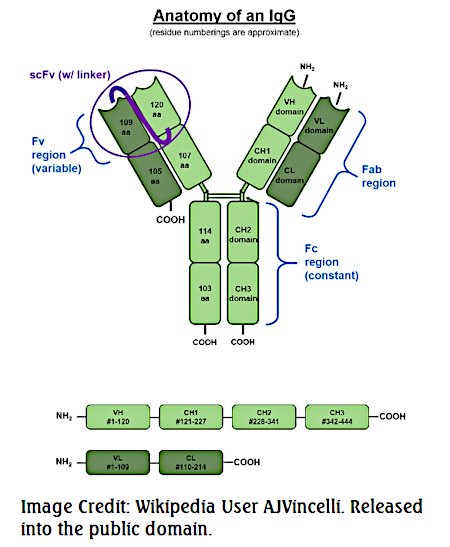
The presence of IgG autoantibodies is a hallmark of PF and PV.
IgG is an immunoglobulin. It is the most abundant immunoglobulin in the body and is necessary for proper function of the immune system. As a matter of fact, it is the only antibody class that can cross the placental barrier. This allows the mother to bestow some of her immunity on the fetus.
IgG is not the only autoantibody involved in the development of pemphigus, but it is the most predominant. It is also implicated in a number of other autoimmune diseases.
Desmoglein 1 and Desmoglein 3
Most of us know that keratin is contained in hair, nails and skin. Keratinocytes manufacture and store keratin, and are the basic building blocks of the epidermis. Keratinocytes are held together by extracellular structures called desmosomes. These structures are like the mortar between bricks in a wall. Desmosomes are comprised of two glycoproteins, desmoglein and desmocollin.
Remember, in PF and PV, it is desmoglein that is destroyed by autoantibodies. So, if the desmoglein is destroyed, desmosome, the intracellular mortar between keratinocytesis is destroyed. The keratinocytes are no longer held together. The basic building blocks of the skin separate, and the skin literally falls apart. Blisters form in the gaps that open up.
I made a GIF to demonstrate how the structure of the skin is undermined by the destruction of desmoglein. Here the mortar between the bricks in a wall slowly erodes and the bricks fall away. Compare this GIF to the image of tissue undergoing the process of acantholysis, a little further down in the blog.

Illustration of Desmosome Cell Adhesion
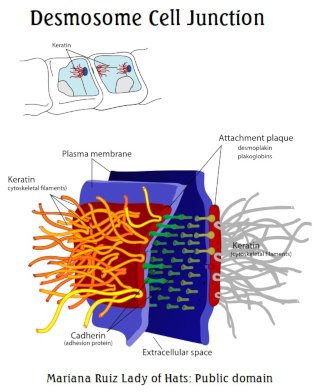
Desmosomes are only one type of intracellular juncture in animal tissue. Most of us are more familiar with another kind: cartilage. Both desmosomes and cartilage are designed to bear weight and to allow for flexibility. You can see in the illustration above that fibers connect one cell to another at an adhesion point called a cadherin. It is the cadherin that is is made up of desmoglein. This is precisely the area of vulnerability in pemphigus.
Below is a microscopic image of tissue taken from a patient who has PV. Even with the untrained eye, we can see gaps in the tissue. According to the description that appears under this photo, "an early intraepidermal vesicle" is evident in this tissue.2 That is, blisters are already forming, and are evident. Compare this gap to the gap in my brick wall GIF.
The process by which desmosomes are destroyed and epithelial tissue separates is called acantholysis.
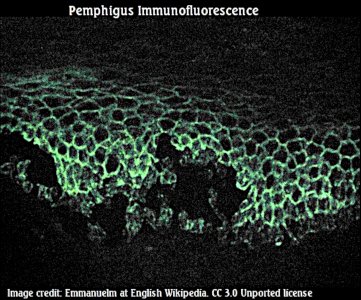
A Personal Digression
In the title of this blog I refer to a personal perspective. Here it is: my experience does not resemble in any way what I have just described. Despite the diagnosis of pemphigus vulgaris, based on two biopsies, a blister never formed. Both pathologists did find that IgG autoantibodies were attacking desmoglein 3 in the biopsied tissue. By the time I showed my doctor the spot, almost two years had passed (!).
The spot had grown a bit, but it was still under 2 cm. I thought I might have a modest squamous cell carcinoma.
I was wrong.
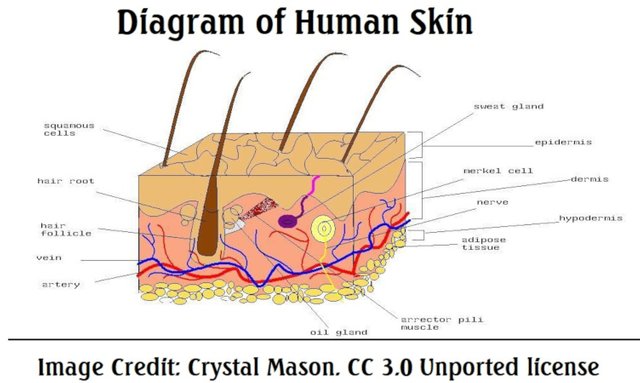
I selected this diagram out of many because it indicates that squamous cells are near the surface of the skin. Stratified squamous epithelium comprise the epidermis. It is here, in the squamous cells, that pemphigus (PV and PF) develops. These cells are flat (wider than they are high) and are arranged in layers.
The image below shows the lining of a normal esophagus. Stratified squamous cells are visible. The esophagus is lined with a mucous membrane, which means it is vulnerable to the development of PV, but not PF.
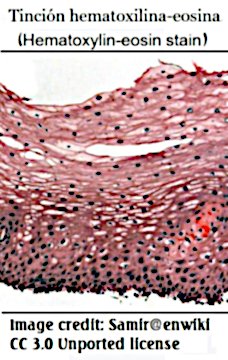
In PV, mucous membranes are often the first sites affected. Typically, oral lesions appear. Because of this, dentists can play an important role in detecting the disease. Mucosal involvement may extend to the esophagus, the nose and even inside the eyelids. (Both pemphigus vulgaris and pemphigus foliaceus may effect the eyelids.)
Before the advent of modern treatment, oral and esophageal lesions inhibited eating, and this contributed to mortality.
Clinical Manifestations of Pemphigus
While pemphigus is broadly described as being either pemphigus foliaceus or pemphigus vulgaris, based on histology, there are subdivisions of these two types. It's hard to get different sources to agree on what these subdivisions are, so I settled for the grouping offered by NORD, National Organization for Rare Diseases. Please note, these subdivisions may overlap, or appear sequentially.
NORD lists six subdivisions, two of these have already been discussed in some detail:
Pemphigus Foliaceus
Pemphigus Vulgaris
I'll say a few words about the other four subcategories:
Endemic Pemphigus
I referred to this earlier in the blog as occurring in the rainforests of Brazil and Colombia. I have also read an article which relates similar cases in Peru to the same type of endemic disease. The suspicion has always existed that an environmental factor triggers the disease in genetically susceptible individuals. A fascinating 2016 article in the Journal of Immunology suggests that the environmental exposure might be the bite of a sandfly. In this case, pathogenic IgG4, instead of IgG1 (which is often the culprit) is implicated.
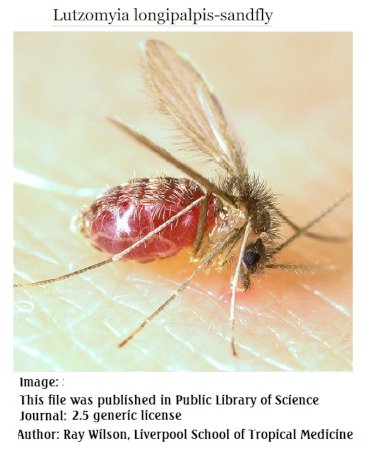
Sandflies are found all over the world, but this variety is only found in the so-called 'New World'--which would encompass Brazil, Peru and Colombia, the countries where endemic pemphigus has been identified.
Pemphigus Erythematosus (Senear-Usher syndrome)
This may be an overlap disease with lupus erythematosus. Patients have serology that is positive for lupus (ex: anti-SM and double-stranded DNA antigens, hallmarks of lupus) and also have histology and clinical presentation compatible with pemphigus.
Pemphigus Vegetans
This is described by most sources as a rare, localized, benign form of PV. Partly because of its rarity, it can be difficult to diagnose.
Drug-Induced Pemphigus
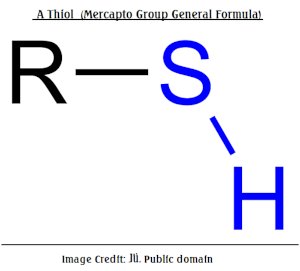
The -SH in the formula above is a sulfhydryl, and it is this that characterizes the thiol group of drugs. This group of drugs is implicated in the development of pemphigus.
This is probably one of the most important parts of my blog today: pemphigus may be caused by drugs that are commonly prescribed. In many cases, the disease will clear up when the drug is withdrawn, but this is not always the case. Also, pemphigus may not develop until months after the drug has been commenced, so it's hard to draw a relationship between the drug and the disease. According to StatPearls, drugs are actually the most likely cause of pemphigus, especially pemphigus foliaceus.
Certain classes of drugs are more closely associated with the disease than others. Thiols (especially d-penicillamine) have been implicated. Phenols have also been implicated. Interestingly, diet can also be a source of phenols and thiols, so foods that contain these...chives, garlic, onion, black pepper, cashew and mangoes...should be avoided by anyone who has been diagnosed with pemphigus.
According to DermNet NZ, about 50% of the cases caused by thiols will clear up when the drug is withdrawn. Disease caused by non-thiol drugs, "have a better prognosis".3
Anti-hypertensives and NSAIDs have also been implicated.
Treatments
The cornerstone of treatment remains corticosteroids, administered systemically, topically or a combination of the two. These drugs can have serious side effects, including: cataracts, diabetes, osteoporosis, psychosis, chronic migraine and increased susceptibility to infection. The effects have been found to be dose dependent. The goal, for physician and patient, is to take the lowest effective dose. This treatment strategy is referred to as 'steroid sparing', and it often involves a balancing act between drug efficacy and drug effects.
Some other treatments for pemphigus are:
Azathioprine
Cyclophosphamide
Mycophenalate
Methotrexate
Rituximab
Dapsone
IV infusion of immunoglobulin
Plasmapheresis
Causes/Antagonists
We've already covered drugs and diet. Genetics seems to play a weak role, particularly in some families. According to GARD, Genetic and Rare Diseases Information Center, " Predisposition...is linked to genetic factors...histocompatibility complex (MHC) class II molecules, in particular alleles of human leukocyte antigen (HLA) DR4, appear to increase susceptibility to pemphigus vulgaris."
There are known environmental antagonists, besides drugs, diet and, possibly, sandflies. One of these, very avoidable, is the sun..or any form of UV radiation.
Ending on a Personal Note
I have a serious UV allergy, which encompasses not only sun but indoor sources of UV. This may be one of the factors that has kept pemphigus at bay all these years. I avoid the sun. My wardrobe offers evidence of that. I have a closet full of hats. So I decided to end the blog on a rather humorous note: a GIF that shows just some of my hats :)

Anyone who wants to use any of my GIFs, for any reason, may do so without restriction.

Footnotes
1Merck Manual Professional Version: Pemphigus Vulgaris
3DermNet Drug-induced pemphigus
Some Sources Used in Writing This Blog
Sequence Characterization of DSG3 Gene to Know Its Role in High-Altitude Hypoxia Adaptation in the Chinese Cashmere Goat https://www.frontiersin.org/articles/10.3389/fgene.2018.00553/full
Companion Animals, Too, Can Get Pemphigus http://www.pemphigus.org/companion-animals-too-can-get-pemphigus-2/
Pemphigus in Dogs https://vcahospitals.com/know-your-pet/pemphigus-in-dogs
Pemphigus Vulgaris https://www.merckmanuals.com/professional/dermatologic-disorders/bullous-diseases/pemphigus-vulgaris
Orphan Products: Hope for People With Rare Diseases https://www.fda.gov/drugs/drug-information-consumers/orphan-products-hope-people-rare-diseases
Pemphigus http://www.pemphigus.org/research/clinically-speaking/pemphigus/
Mechanisms of Disease: Pemphigus and Bullous Pemphigoid https://www.ncbi.nlm.nih.gov/pmc/articles/PMC5560122/
Nature and functions of autoantibodies https://www.ncbi.nlm.nih.gov/pmc/articles/PMC2703183/
Layers of the Skin http://library.open.oregonstate.edu/aandp/chapter/5-1-layers-of-the-skin/
Usefulness of desmoglein 1 and 3 in serodiagnosis of pemphigus vulgaris and its correlation with disease activity - ELISA study http://www.jofs.in/article.asp?issn=0975-8844;year=2014;volume=6;issue=2;spage=104;epage=107;aulast=Gandhi
Definition of human autoimmunity--autoantibodies versus autoimmune disease https://www.ncbi.nlm.nih.gov/pubmed/19963079
Immunoglobulin G https://www.sciencedirect.com/topics/neuroscience/immunoglobulin-g
Natural Antibodies Bridge Innate and Adaptive Immunity http://www.jimmunol.org/content/jimmunol/194/1/13.full.pdf
Serum IgG Subclasses in Autoimmune Diseases https://www.ncbi.nlm.nih.gov/pmc/articles/PMC4602543/
Kinetin Improves Barrier Function of the Skin by Modulating Keratinocyte Differentiation Markers
https://www.ncbi.nlm.nih.gov/pubmed/28223740Desmocollin and desmoglein – different roles in desmosomes http://jcs.biologists.org/content/127/10/e1001
Learn more about Acantholysis https://www.sciencedirect.com/topics/medicine-and-dentistry/acantholysis
Potential Risk Factors for Cutaneous Squamous Cell Carcinoma include Oral Contraceptives: Results of a Nested Case-Control Study https://www.ncbi.nlm.nih.gov/pmc/articles/PMC2872290/
Pemphigus vulgaris presenting as gingival involvement https://www.ncbi.nlm.nih.gov/pmc/articles/PMC3505431/
When the Eyes Have It http://www.pemphigus.org/when-the-eyes-have-it-2/
Endemic pemphigus in the peruvian Amazon: epidemiology and risk factors for the development of complications during treatment http://www.scielo.br/scielo.php?script=sci_arttext&pid=S0365-05962012000600003
Overlapping IgG4 Responses to Self- and Environmental Antigens in Endemic Pemphigus Foliaceus http://www.jimmunol.org/content/196/5/2041
A New Classification System for IgG4 Autoantibodies https://www.ncbi.nlm.nih.gov/pmc/articles/PMC5816565/
Autoantibodies in Senear-Usher Syndrome: Cross-Reactivity or Multiple Autoimmunity?
https://www.ncbi.nlm.nih.gov/pmc/articles/PMC3539423/Pemphigus vegetans: An unusual presentation https://www.ncbi.nlm.nih.gov/pmc/articles/PMC3505428/
Drug Induced Pemphigus https://www.ncbi.nlm.nih.gov/books/NBK499864/
Drug-induced pemphigus https://www.dermnetnz.org/topics/drug-induced-pemphigus/
Antihypertensives in dermatology Part II - Cutaneous adverse reactions to antihypertensives http://www.ijdvl.com/article.asp?issn=0378-6323;year=2018;volume=84;issue=2;spage=137;epage=147;aulast=Ranugha
Pemphigus vulgaris https://rarediseases.info.nih.gov/diseases/7355/pemphigus-vulgaris
Adverse effects of oral corticosteroids in relation to dose in patients with lung disease https://www.ncbi.nlm.nih.gov/pmc/articles/PMC1746020/
Patterns of steroid and steroid sparing regimens among older inflammatory bowel disease (IBD) patients with contraindications to tumor necrosis factor antagonists (ANTI-TNFS) https://www.valueinhealthjournal.com/article/S1098-3015(14)00294-0/fulltext
Azathioprine in the treatment of Autoimmune Blistering diseases http://www.pemphigus.org/azathioprine-in-the-treatment-of-autoimmune-blistering-diseases/
A comparative effectiveness research of azathioprine and cyclophosphamide on the clinical and serological response in pemphigus vulgaris http://www.e-ijd.org/article.asp?issn=0019-5154;year=2016;volume=61;issue=4;spage=418;epage=426;aulast=Sardana
Medline ® Abstract for Reference 5 of 'Initial management of pemphigus vulgaris and pemphigus foliaceus' https://www.uptodate.com/contents/initial-management-of-pemphigus-vulgaris-and-pemphigus-foliaceus/abstract/5
Methotrexate in the treatment of pemphigus vulgaris: experience in 23 patients https://www.ncbi.nlm.nih.gov/pubmed/23772610
FDA Approves Genentech’s Rituxan (Rituximab) for Pemphigus Vulgaris
https://www.gene.com/media/press-releases/14727/2018-06-07/fda-approves-genentechs-rituxan-rituximaDapsone in the treatment of pemphigus vulgaris: adverse effects and its importance as a corticosteroid sparing agent https://www.ncbi.nlm.nih.gov/pmc/articles/PMC4540507/
Effect of Intravenous Immunoglobulin Therapy on Serum Levels of IgG1 and IgG4 Antidesmoglein 1 and Antidesmoglein 3 Antibodies in Pemphigus Vulgaris https://jamanetwork.com/journals/jamadermatology/article-abstract/420177
Plasmapheresis in Refractory Pemphigus Vulgaris: Revisiting an Old Treatment Modality Used in Synchrony With Pulse Cyclophosphamide https://www.mdedge.com/dermatology/article/97747/wounds/plasmapheresis-refractory-pemphigus-vulgaris-revisiting-old
Pemphigus vulgaris https://rarediseases.info.nih.gov/diseases/7355/pemphigus-vulgaris
Sun Exposure http://www.pemphigus.org/tag/sun-exposure/
Photosensitivity https://www.ncbi.nlm.nih.gov/books/NBK431072/
Oh boy. Lucky indeed, in your unluckiness.
Interestingly, all of those (except black pepper) are not to be eaten on the low-FODMAP diet, a common recourse for those with gastrointestinal issues. One more thread in the gut-autoimmune connection, I guess.
That's a veritable hat fetish you have there!
He He. Half of those hats were gifts.
And that gut connection...oh yeah.
Thanks for stopping by, @alexander.alexis :)
I just read this in the book The Paleo Approach: "Celiac disease, multiple sclerosis, dermatitis herpetiformis, and bullous pemphigoid have been definitively linked to gluten as an environmental trigger."
I assume you don't eat gluten? I remember you mentioned not getting along with fiber.
Thank you so much. No gluten. Processed fiber, in small amounts. I've recently discovered organic maple syrup. I tolerate it really well and seem to feel better with it in my diet.
That's an amazing read..that they even mention pemphigus is astonishing.
As for the hats (going back to that 😃): it's hard when you have to wear a hat everywhere, indoors and out. For a while, everyone had fluorescent lights. These are pathogenic for me, as are halogens. My family started bringing home hats of every kind when they went on vacation. Now LEDs are replacing the old UV emitting bulbs, and life is much easier. I can actually venture in most stores and restaurants without a hat. 😁
Thanks again for the information. Hope you are well.
I think you were a bat in your previous life.
😂
Wow! Such a personal post. I am impressed by the courage it should have required for you to survive the disease for more than 20 years (and maybe more?). How is the research in potential treatments going? Any hope on this side to see something better and new?
Hi @lemouth, thanks so much for those kind words. Not courage...an awareness of good fortune. Mine was restricted to one lesion and the knowledge that this is part of my medical profile. The first time I went to the pemphigus specialist I was a bit frightened. She told me that eveyone (there were many) who was in her waiting room had pemphigus and they were all doing fine. They certainly looked fine.
In the US, as you know, one of the biggest issues in health is access to care. In my case, that was never an obstacle. But for all autoimmune diseases, as a class, as you also know, there is little that can be done to control the course of active, refractory disease beyond some rather brutal drug regimens. I think hope rests in looking at causes--those causes often rest in the environment. Many articles here on SteemSTEM address that. I'm thinking of @chappertron and @scienceblocks in particular, who address epigenetic influences and how we might affect them. SteemSTEM is a science library :)
I really appreciate your stopping by and commenting. For me, feedback and networking are most rewarding.
I would have personally felt really scared if a doctor would have asked me to come back for more tests. For some reasons, I usually always think about the worst option. And living in the US makes it even worse (as you said, this is a country where a decent health is somehow a luxury, in my understanding of you system).
I tend to jump to the worst case also, but I'd been through a few rather weird scares already and learned I couldn't panic every time the prospect of bad news came my way. Now I stay calm and hope for the best. So far, my luck has held out 🙂 One day, that won't be true, but that's how we all end up, isn't it.
And yes, healthcare is a luxury in this country. That is cruel and immoral. It must seem like madness to you and others who see healthcare as a basic right. It seems like madness to me also. Many of us are working for change.
I appreciate your empathy. I do love Steemit because I get to meet people like you.
There is only one certainty: we are all slowly moving towards death. No matter who we are, this is how it is :)
Thanks for the nice words! I hope the US will see a change soon (I have doubts about it, but I still have hope in the American people).
This was an amazing post. Reminded me of a similar disease I attended a meeting about. The disease is called Epidermolysis Bullosa or EB. The one in which skin almost falls off and you have hard time even scratching yourself in peace, because that will make lesions come up. I was horrified after meeting those patients, it was so painful. Turns out PV is in the list of differential diagnosis for EB. Like you mentioned PV and related diseases occur because of autoantibodies attacking the proteins that keep the structure together, EB happens because of mutations in genes like keratin 5 or 14, col7, proteins of basal lamina.
Anyway, glad to hear that you are doing ok now. Stay stress free and eat healthy. Hope it never returns back.
Thanks for sharing this.
Posted using Partiko Android
Thank you so much. Your kindness always shines through your writing. Putting together a science article for me is a little like going back to school. I know some things and have to learn much more. That for me is a relaxing exercise. And there's always the chance someone will read the piece and get something useful out of it. When my articles pass muster in the science community--that is gratifying.
I think I told you in a comment once that my family has a peculiar experience with autoimmune disease. I won't give the list here...but my brother was struck with voltage gated potassium channel autoimmune limbic encephalitis a few years back. The usual weapons--massive doses of corticosteroids and immunoglobulin brought him back(mostly). He also benefited from being near an excellent medical facility (Emory University) and having the resources to access care.
It would be nice if we could more precisely understand the nexus between environment and genetics before a pathology developed. And it would be really nice if everyone had the means to take your advice: stay stress free and eat well. Unfortunately, we're a long way from both goals.
I wish you and your family good health. Have a most peaceful day.
Hi @agmoore2!
Your post was upvoted by Utopian.io in cooperation with @steemstem - supporting knowledge, innovation and technological advancement on the Steem Blockchain.
Contribute to Open Source with utopian.io
Learn how to contribute on our website and join the new open source economy.
Want to chat? Join the Utopian Community on Discord https://discord.gg/h52nFrV
Thank you, @utopian-io. I'm very grateful.
This post has been voted on by the SteemSTEM curation team and voting trail. It is elligible for support from @curie and @utopian-io.
If you appreciate the work we are doing, then consider supporting our witness stem.witness. Additional witness support to the curie witness and utopian-io witness would be appreciated as well.
For additional information please join us on the SteemSTEM discord and to get to know the rest of the community!
Thanks for having added @steemstem as a beneficiary to your post. This granted you a stronger support from SteemSTEM.
Thanks for having used the steemstem.io app. You got a stronger support!
Thank you, Steemstem, very, very much!
Fantastic blog. Kudos for all your research. I never heard of this disease before. Your postings are a credit to the Steemit community. Keep up the great work.
Thank you! I really appreciate that. Thank you so much for stopping by and reading my blog.
I am sorry, I missed this post to give a vote :( But I recently am seldom on steemit.
It is astonishing that one can find causes and methods of treatment at all, in the multitude of illnesses and then also establish the connection to medication.
I'm not sure whether it was good fortune that made you overcome this disease, even let you survive. You know that I am convinced that bodily functions are also mentally influenced and that stress is a factor that can influence the course of a disease, as has already been said here in the comments section. The body initially responds with strange disturbances when a person behaves against his needs. In connection with a recent family autoimmune disease, I have read that permanent tension - literally understood here - makes the organs' work more difficult and that an abdomen that is in a permanent state of tension favours diseases. If, for example, you do not integrate regular meal breaks into your working hours, eat on the side, eat your food in a hurry, you disturb the work of the organs and the processes in a way that could be compared to a sloppily written essay. Punctuation, semantics do not follow the rules. If the flow and working processes in the body are blocked, if the substances cannot be qualitatively converted or transported, the body will eventually turn against its host.
Therefore, my question to you would be whether you have changed your eating habits in the context of the diagnosis, not only what you eat, but also how you eat. Slow chewing, preparing food better for the stomach, several small meals instead of big ones, etc.? From my point of view, eating in company or alone also makes a big difference in how fast or slow you eat your food. I mainly eat alone, I have to force my son to sit down at the table and take it consciously. Whenever I live among several people, I feel better overall, because I eat more regularly and feel more happy preparing the food when six people sit at the table instead of two.
All this said, I know that all the other reasons you mentioned are valid, but as always, I wanted to add my point of view.
I like your hats! I myself have a sun allergy since round about four years. I must wear long sleeves, as it's my hands which suffer the most. But I also must protect my face as I easily get sun burned but without the itching consequences my hands endure. My man recently gifted me a sun protector which, for the first time, not only protects my hands but also has a healing effect on the skin. It's from eco cosmetics, 100% natural origin, 98% organic vegetal, 28,6 % organic:
https://www.naturdrogerie.shop/eco-cosmetics/sonnenlotion-neutral-lsf-30-ohne-parfum
only German, sorry.
So nice to see you, Erika. I think we might be related 😎
What you say about stress is so true. I lead a quiet life, even a privileged life. I think the major stresses in my life occurred long before I had control--and those early stresses do take a toll, later on.
Eating...not too much folly there :). Not anymore, anyway 🙂
Your hands...interesting. Is it just sun, or temperature also? There's something called Reynaud's syndrome in which hands are affected by changes in temperature.
Thanks for that link to the sunscreen. Usually titanium dioxide and zinc oxide are good (no reaction) for me, but generally the recommendation is to avoid sun exposure as much as possible. @alexander.alexis had a thought: maybe I was a bat in my past life 😅
Be peaceful, and well.
AG
It's clearly the UV and allergy against sun light. I only get it in summer when I expose myself too much to the light. My brother gets it, too. Skin sensitivity is something the whole family lives with. Guess, you and me might stem from a bat family. LOL.
Speaking of sun: today is a lovely day and we will visit again the STAMP Festival, as every year. Unfortunately there are less artists and more consumption.
Kisses!
Erika
Have fun, friend :)
Hey @agmoore2, this post looks pretty cool again. I will read it in detail tomorrow. Thanks & respect
Chapper
Thanks, @chapper, for stopping by. I used a GIF to illustrate my point, but not a science GIF :)
No trouble about the non-science gif. The article is pretty cool again. At the first place, I was surprised to find a new disease I never heard before. But then a saw the term Usher. A friend of mine did research on the Usher syndrome and therefore I know these kinds of diseases are very rare. Because of this reason, unfortunately, not that much research is made and therefore again no good therapies are available.
But it's good that you received a therapy that worked immediately without all these horrible side-effects or long-lasting suffering.
Enjoy your Sunday
Best
Chapper
Hi Chapper, Thanks for finding my article 'cool'. 🙂 I don't really like to wax personal on Steemit, but this seemed to be a tangentially personal topic. It all worked out well mostly because of good fortune, but also because I had access to an internationally acknowledged specialist in pemphigus at NYU.
I'd never heard of Usher Syndrome, but looked it up. Apparently, this is a different Usher, Charles Usher. USFDA also characterizes Usher Syndrome as an orphan disease, as you indicate.
It took a little work to track down the Usher in Senear-Usher Syndrome. This is Barney David Usher. I'm sharing this with you because he has the unique distinction (!) of being the first Canadian dermatologist to have a disease named after him. This is the sort of trivia that might come in handy if you're ever a contestant on a TV quiz show 😁
I do appreciate your support, very, very much.
Have a great Sunday (which is probably almost over for you now) and a peaceful work week.
Warm regards,
AG
Haha, this is very interesting and yes it has the potential to be one of these game show trivia questions. When I win 1 Mio in a show like this you get rewarded!
Btw. I also try to prevent to get to personal here, but the people like it sometimes.
To support articles likes yours is my duty and honor at the same time.
Have a nice week
Chapper
Congratulations @agmoore2! You have completed the following achievement on the Steem blockchain and have been rewarded with new badge(s) :
You can view your badges on your Steem Board and compare to others on the Steem Ranking
If you no longer want to receive notifications, reply to this comment with the word
STOPVote for @Steemitboard as a witness to get one more award and increased upvotes!